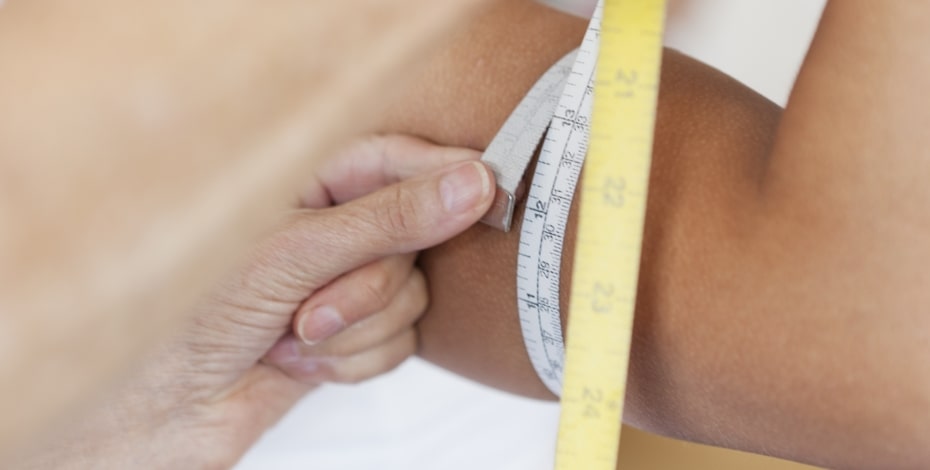
Measurement of breast-cancer-related lymphoedema

The measurement of lymphoedema might seem simple but the more you think about it, the more complexity becomes evident. In the current issue of Journal of Physiotherapy, Associate Professor Elizabeth Dylke’s Invited Topical Review discusses physiotherapy measurement of breast-cancer-related lymphoedema.
You describe circumference measurements with a tape measure at certain points along the limb as the most clinically used method of measuring and monitoring for changes in a limb with or at risk for lymphoedema. Why is that? Do they have disadvantages?
Circumference measurements use very inexpensive and easily accessible equipment, particularly in comparison to the majority of the other assessment methods for lymphoedema.
They can also be quick to complete, depending on how many your protocol suggests you use.
The major disadvantage is that their reliability is dependent on how carefully the measurement protocols are followed, particularly in terms of how tightly the tape measure is pulled.
On a soft fluid-filled limb, the measured circumference can change quite significantly if the tape measure is pulled tightly.
The aim usually is for little tension to be applied so that the arm shape is not distorted.
Next, you discuss whole limb volume measurements. Readers might already be familiar with the water displacement method. What are its pros and cons?
Water displacement has been used for a long time to determine the volume of objects as well as limbs with lymphoedema.
It can be undertaken with fairly simple equipment, although there are also commercial water displacement volumeters that may be more complicated and expensive.
It is very reliable if protocols are followed carefully.
However, it’s rarely used in Australia because it can be time-consuming as well as awkward.
Large containers of water need to be moved around and cleaned after each use, which is both a workplace health and safety and an infection control issue.
Then the review discusses perometry, which covers several types of optical volumetry.
If there are many protocols for this sort of measurement, does that make it hard to compare perometry results from different methods?
Currently there are not many optical volumetry tools being used beyond the perometer, but it’s an interesting area for development in the future.

Associate Professor Elizabeth Dylke's research focus is on oncology rehabilitation and the assessment and management of lymphoedema.
We’ve just published a study looking at the reliability of three-dimensional surface imaging, which uses pictures taken from multiple angles to measure breast volume in those with breast lymphoedema.
There are still some reliability issues and, again, following the assessment protocol is critical but it will be interesting to see how this technology improves and changes how we assess limb and body region volumes.
Readers may be aware of bioimpedance measures for other purposes but you explain that it is now being used in the detection of early breast-cancer-related lymphoedema.
Bioimpedance was actually first suggested for lymphoedema in the 1980s, with the first large study published in 2001.
It’s quite widely used in Australia as part of both the early detection and the ongoing monitoring of lymphoedema.
Bioimpedance assessment gives us a measurement of the extracellular fluid volume in a body region and this is the fluid that increases in lymphoedema.
In early or developing breast-cancer-related lymphoedema, we are looking for small changes in extracellular fluid levels and bioimpedance has been shown to be able to detect this.
Bioimpedance may have a role in assessing changes in the tissue composition of a limb, particularly in fat tissue volume, for more progressed lymphoedema as well.
Finally, you talk about tissue dielectric constant assessment, which assesses the amount of water in the underlying skin tissues locally rather than making an overall assessment of volume. Can you take measures at multiple sites and extrapolate?
It’s really only used for spot measurements rather than extrapolating to an overall assessment of volume.
Spot measurements are quite useful because the presentation of lymphoedema can vary in different parts of a limb and that may be lost when the whole limb is assessed.
Circumference measurements also provide insight into localised changes, which is another argument for using them over whole arm volume assessments such as water displacement.
>> Associate Professor Dr Elizabeth Dylke is Head of Physiotherapy at the University of Sydney and President of the Australasian Lymphology Association. Elizabeth’s research focus is on oncology rehabilitation and the assessment and management of lymphoedema. She is passionate about supporting new researchers and clinically driven research questions.
© Copyright 2024 by Australian Physiotherapy Association. All rights reserved.





